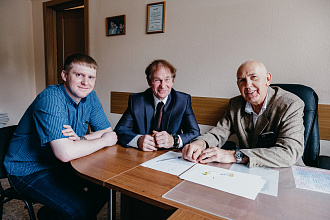Scientists on the road to optically controlled computers
15 October 2020 г.

Switching magnetization in a magnetic field is the main principle of modern data storage technology. In computers with magnetic memory, the recording and reading of information is provided due to electromagnetic interaction with external devices and this allows data to be transmitted at a rate of one bit per nanosecond or faster.
The development of wireless technologies and the demand for cloud storage systems increase the need for fast information recording. In principle, scientists are familiar with methods to increase the speed of modern computing devices. For example, the possibility of exciting magnetic vibrations in iron oxides has already been shown. However, the physical mechanism of the change in the exchange interaction upon the excitation of a substance by light remained a mystery until recently.
Scientists of the Federal Research Center "Krasnoyarsk Science Center of SB RAS" together with colleagues from St. Petersburg, Great Britain and the Netherlands have developed a theory of the exchange interaction of optically excited magnetic ions and found out what happens to electrons when the crystals of iron oxides are exposed to laser radiation. Understanding this process opens the way for the targeted control of the magnetic properties of materials with the help of light.
The researchers studied the electron exchange in ferroborate crystals, composed of iron, oxygen and boron. After lengthy experiments, it was found that the exchange interaction of electrons changes in the crystal after irradiation with intense ultrashort light pulses, but how and why this happens remained unknown. Scientists notes that it is the laser pulse that activates the transfer of charges, thereby modifying the exchange coupling between neighboring iron ions in the crystal lattice. The peculiarity of the process is that iron ions are located in the center of the oxygen octahedra adjacent to them, therefore, the redistribution of electrons occurs very fast. Without light irradiation, the exchange interaction of the neighboring ions is antiferromagnetic, that is, their magnetic moments are antiparallel. The theory of the Krasnoyarsk physicists reveals that if an iron ion is excited by light with a certain frequency, and the neighboring one remains unexcited, then the interaction becomes ferromagnetic.
To confirm their theory, the researchers decided to conduct an experiment on another crystal - erbium orthoferrite, which is composed of iron, oxygen and a rare earth metal - erbium. The measurement results were identical to the previous ones. So scientists have identified the mechanism of the influence of light on the process of electron transfer and change in the exchange interaction in iron oxides. It is important that after the absorption of a light particle by one of the two metal ions and change in magnetization, their magnetic moments become almost parallel. Prior to this, only the exchange interaction of ions in the unexcited state was taken into account in magnetism. Now scientists have described and experimentally found that under the action of light, there occurs the resonant excitation of the transition of electrons from one magnetic sublevel to another, including a change in angular momentum. This discovery demonstrates an alternative to the currently used theory of ultrafast interactions of light with electronic magnetic moments.
“To control the exchange interaction using subpicosecond laser pulses is a very attractive approach for finding a new scenario for the fastest control of magnetism. This effect will speed up the work of computers due to the optical control of the processes of the information recording and reading. Many people want computers to run faster. In the XXI century, femtosecond magneto-optics began to intensively develop, demonstrating the ability to control the magnetic properties of a substance in times of the order of one femtosecond, which means the possibility of accelerating the recording and reading of information in comparison with the current technology by a factor of a million! " – shares the investigation results Doctor of Physical and Mathematical Sciences, Professor, Head of the Laboratory of the L.V. Kirensky Institute of Physics, Sergei Ovchinnikov.
Physicists note that studies of momentum dynamics are likely to lead to unexpected discoveries. In particular, understanding the mechanism described by the scientists will allow one to control the magnetic order of matter with the help of light and thereby, it will aid in finding new ways of recording information at times much faster than a nanosecond, and without using external magnetic fields.
The study was supported by the Russian Science Foundation (grant No. 18-12-00022).
Share:





